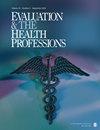Factor Structure, Reliability, and Convergent Validity of an Ecological Momentary Assessment Binge-Eating Symptoms Scale
IF 2.2
3区 医学
Q2 HEALTH CARE SCIENCES & SERVICES
引用次数: 0
Abstract
Ecological momentary assessment (EMA) of binge-eating symptoms has deepened our understanding of eating disorders. However, there has been a lack of attention on the psychometrics of EMA binge-eating symptom measures. This paper focused on evaluating the psychometric properties of a four-item binge-eating symptom measure, including multilevel factor structure, reliability, and convergent validity. Forty-nine adults with binge-eating disorder and/or food addiction completed baseline questionnaires and a 10-day EMA protocol. During EMA, participants completed assessments of eating episodes, including four binge-eating symptom items. Analyses included multilevel exploratory factor analysis, computation of omega and intraclass correlation coefficients, and multilevel structural equation models of associations between contextual factors and binge-eating symptoms. A one within-subject factor solution fit the data and showed good multilevel reliability and adequate within-subjects variability. EMA binge-eating symptoms were associated with baseline binge-eating measures as well as relevant EMA eating characteristics: including greater unhealthful food and drink intake; higher perceived taste of food; lower likelihood to be planned eating; and lower likelihood of eating to occur at work/school and other locations and greater likelihood to occur at restaurants compared to home. In conclusion, the study findings support the psychometrics of a 4-item one-factor EMA measure of binge-eating symptoms.生态学瞬间评估暴食症状量表的因子结构、可靠性和收敛有效性
暴食症状的生态瞬间评估(EMA)加深了我们对进食障碍的了解。然而,人们对 EMA 暴食症状测量的心理测量学一直缺乏关注。本文重点评估了四项暴食症状测量的心理测量特性,包括多层次因子结构、可靠性和收敛有效性。49 名患有暴食症和/或食物成瘾的成年人完成了基线问卷和为期 10 天的 EMA 方案。在 EMA 期间,参与者完成了对进食发作的评估,包括四个暴食症状项目。分析包括多层次探索性因子分析、欧米茄系数和类内相关系数计算,以及环境因素与暴食症状之间关联的多层次结构方程模型。一个受试者内因子解决方案符合数据,并显示出良好的多层次可靠性和足够的受试者内变异性。EMA 暴食症状与基线暴食测量以及相关的 EMA 饮食特征相关:包括更多不健康食物和饮料的摄入;对食物味道的感知更高;有计划进食的可能性更低;在工作/学校和其他地点进食的可能性更低,在餐馆进食的可能性比在家里进食的可能性更高。总之,研究结果支持对暴饮暴食症状进行 4 项单因素 EMA 测量的心理计量学方法。
本文章由计算机程序翻译,如有差异,请以英文原文为准。
求助全文
约1分钟内获得全文
求助全文
来源期刊
CiteScore
5.30
自引率
0.00%
发文量
31
审稿时长
>12 weeks
期刊介绍:
Evaluation & the Health Professions is a peer-reviewed, quarterly journal that provides health-related professionals with state-of-the-art methodological, measurement, and statistical tools for conceptualizing the etiology of health promotion and problems, and developing, implementing, and evaluating health programs, teaching and training services, and products that pertain to a myriad of health dimensions. This journal is a member of the Committee on Publication Ethics (COPE). Average time from submission to first decision: 31 days

 求助内容:
求助内容: 应助结果提醒方式:
应助结果提醒方式:


